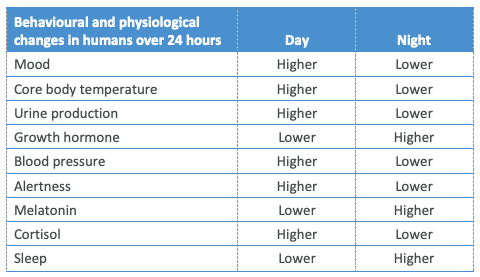What makes us sleep?
Of the two pathways thought to control sleep, it is far more likely that you will have heard of the circadian rhythm pathway so it is here that we will start. Circadian (sir-KAY-dee-an) comes from the Latin Circa Diem which means “around a day”, because a circadian rhythm runs in approximately 24 hour cycles. Crucially, a circadian rhythm is endogenously determined, meaning that it would operate without external cues, but it is entrainable which means that some external cues influence it, though it will operate at different temperatures.
The circadian rhythm which operates to control the human sleep/wake cycle is an example of one such rhythm. You may have experienced yourself that your body will want to be awake during certain approximate hours and want to sleep during other ones, and the frame never shifts all that much in one direction or other. However, after a certain period of adjustment which is colloquially known as jet lag, you can indeed move your waking frame to a different place in the cycle. This is a perfect illustration of the in-built yet modifiable nature of human circadian cycling which controls not only sleeping and waking but also a number of other aspects of physiology and behaviour according to the day/night diurnal pattern in which we live. Below is a table indicating the changes which occur due to circadian rhythmic control in humans.

Here you can see that a huge number of factors alter throughout the 24 hour cycle. For example, your core body temperature will vary by about 1 degree across the day, starting to dip at 10pm at night in anticipation of sleep, it will hit its lowest point at 4am and then start to rapidly increase in anticipation of waking up. This isn’t just small physiology, though – our ability to perform mathematical equations between 4am and 6am is so poor that it’s considered worse than it would be at another time of the day, after you had consumed enough alcohol to be legally classed as drunk. Similarly, although it is possible to force yourself to stay awake your mental alertness at 2am will never be what it would have been during daytime – it’s no coincidence that the Chernobyl disaster occurred during a night shift and that there is a disproportionate amount of car accidents at around 3am than at any other time of day, even when fatigue is taken into account.
Interestingly, however, if you manage to stay awake all night you will start to feel better and would perform better in cognitive tests at around 10am, just like you always would. This shows that the 2am disasters and 3am car accidents cannot just be down to fatigue or tiredness – this is under some form of control.
As you have just learned, these rhythmic changes are controlled endogenously by something within us. Interestingly, although the mechanism by which they are controlled changes the same holds true for life forms as distant from us as Synechoccus elongates, also known as cyanobacteria which display behavioural changes according to the day/night cycle even without the influence of light or temperature. This tells us that 24 hour cycling of behaviour is extremely well conserved across evolutionary time, most likely as this allows an individual to maintain proper sleeping and waking hours despite variable periods of light and darkness according to seasonality and location. But the question remains – how is the 24 hour cycle controlled in humans, and how can the environment entrain it?